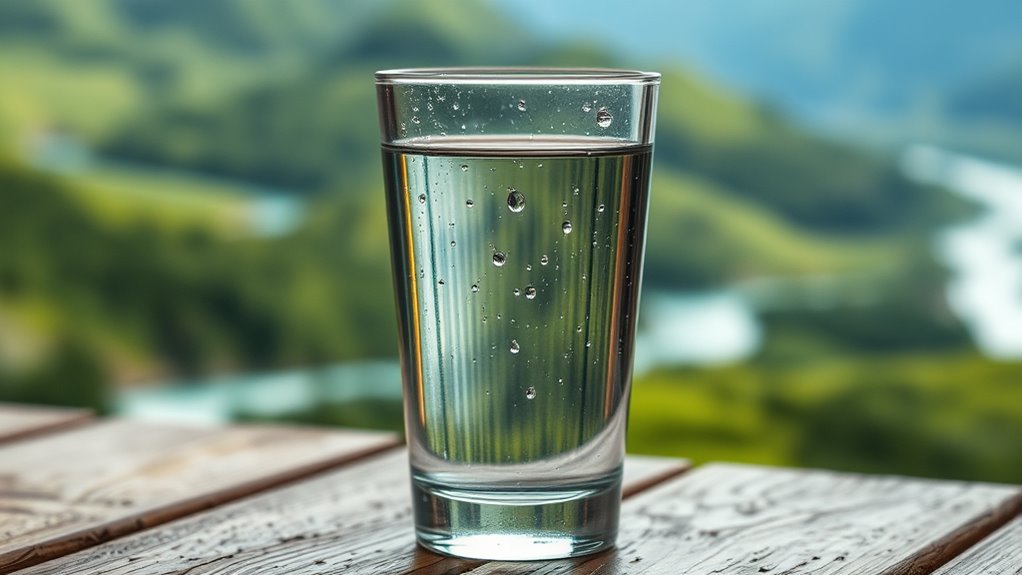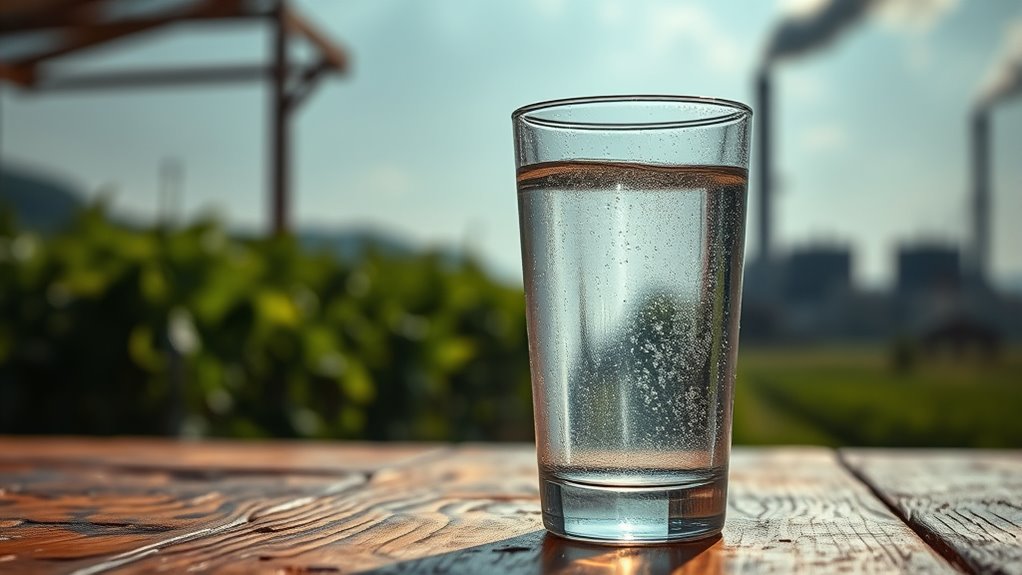Your water footprint includes hidden water—called virtual water—embedded in the products you buy like clothes, coffee, or electronics. This water isn’t visible in everyday sources but is used during manufacturing and supply chains. It impacts global water resources, especially in water-scarce regions, by transferring water through trade. Recognizing this can help you make more mindful choices. Keep exploring to learn how understanding virtual water can help protect our planet’s future.
Key Takeaways
- Virtual water is the hidden water embedded in products and supply chains, not visible in everyday use.
- The water footprint reveals the total water used in producing goods, including hidden virtual water.
- Global trade transfers virtual water, affecting water-scarce regions through imports and exports.
- Consumption habits impact water usage by adding to the hidden water costs of everyday items.
- Understanding virtual water promotes responsible consumption, conservation, and sustainable resource management.

Have you ever wondered how much water goes into producing the food, clothing, and products you use daily? It’s not just the water you see in a glass or that flows from your tap. A lot of it is hidden, known as virtual water— the total amount of water embedded in the manufacturing and supply chain of goods. When you buy a T-shirt, for example, you’re also purchasing the virtual water that went into growing the cotton, processing the fabric, and assembling the final product. This hidden water consumption often goes unnoticed, but it plays a huge role in the broader picture of water usage and sustainability. Understanding the water footprint helps reveal the true environmental impact of our consumption habits. It’s especially important when considering water scarcity, a growing global issue where freshwater resources are limited or unevenly distributed. Many regions face severe water shortages, making it critical to account for the virtual water embedded in imported goods. For instance, importing food or textiles from water-rich countries might seem convenient or economical, but it can contribute to water stress in areas already struggling to meet their own needs. This disconnect highlights the importance of considering not just local water use, but the entire water footprint of products we consume.
By recognizing the concept of water footprint, you gain insight into how your lifestyle influences global water resources. Every item you purchase has a virtual water cost, whether it’s the coffee you drink, the electronics you use, or the clothes you wear. These hidden water costs accumulate, contributing to water scarcity issues worldwide. Countries that export large quantities of agricultural products or manufactured goods often transfer their virtual water to importing nations, sometimes exacerbating water stress in vulnerable regions. Being aware of this helps you make more informed choices— opting for sustainably sourced products, reducing unnecessary consumption, or supporting brands that prioritize water conservation.
The idea of virtual water also encourages you to think about the sustainability of your habits. It’s not just about conserving water locally but understanding the global implications of your consumption patterns. If you’re mindful of the virtual water content in your purchases, you can help reduce the overall demand on water-scarce regions and promote more responsible use of this essential resource. In essence, paying attention to your water footprint means recognizing the unseen costs of your daily life and making choices that support a more sustainable and equitable world.
Frequently Asked Questions
How Is the Water Footprint Calculated for Different Products?
You calculate a product’s water footprint by summing the virtual water used throughout its entire lifecycle, from production to disposal. This includes water for growing raw materials, manufacturing, and transportation. You need to take into account water scarcity in each region, as using water in a dry area impacts local resources more. By understanding this, you can see how your choices contribute to overall water consumption and conservation efforts.
What Are the Main Factors Influencing a Product’S Water Footprint?
You should consider that a product’s water footprint is mainly influenced by factors like industrial impact and water scarcity. When industries use large amounts of water or operate in water-scarce areas, it increases the footprint. Additionally, farming practices, transportation, and processing methods play a role. These factors collectively determine how much water gets consumed, often hidden, emphasizing the importance of sustainable choices to reduce overall water use.
Can Reducing Individual Water Footprint Impact Global Water Scarcity?
Reducing your personal water conservation efforts can substantially impact global water scarcity when combined with collective water management. Your choices, like using water-efficient appliances and reducing waste, help lower overall demand. When many individuals do the same, it creates a powerful movement toward sustainable water use. This collective approach can ease pressure on water resources, support conservation initiatives, and promote a more sustainable future for communities worldwide.
How Do Agricultural Practices Affect Water Consumption?
You might not realize it, but your agricultural practices greatly impact water consumption. Using efficient irrigation methods, like drip or sprinkler systems, helps conserve water, while choosing crops suited to your climate reduces unnecessary use. When you adopt sustainable practices, you lower overall water demand, which benefits the environment and helps address global water scarcity. Your choices in irrigation and crop selection play a crucial role in managing water resources responsibly.
Are There Tools or Apps to Track Personal Water Footprint?
You can find several tools and apps that help with digital tracking of your water footprint, aiding in water conservation. These apps monitor your daily water use, suggest ways to reduce consumption, and raise awareness about your impact. By actively using such tools, you become more conscious of water-saving habits and make smarter choices, ultimately contributing to global water conservation efforts and reducing hidden water consumption in your lifestyle.
Conclusion
By now, you see how your everyday choices quietly shape the water footprint—like a modern-day Pandora’s box, releasing hidden consumption. Every product you buy, eat, or wear has a water story behind it. Just as the ancient aqueducts sustained civilizations, your mindful decisions can conserve this precious resource. Remember, in this interconnected world, your actions ripple through time, making water conservation as essential today as it was in the days of the Roman Empire.









